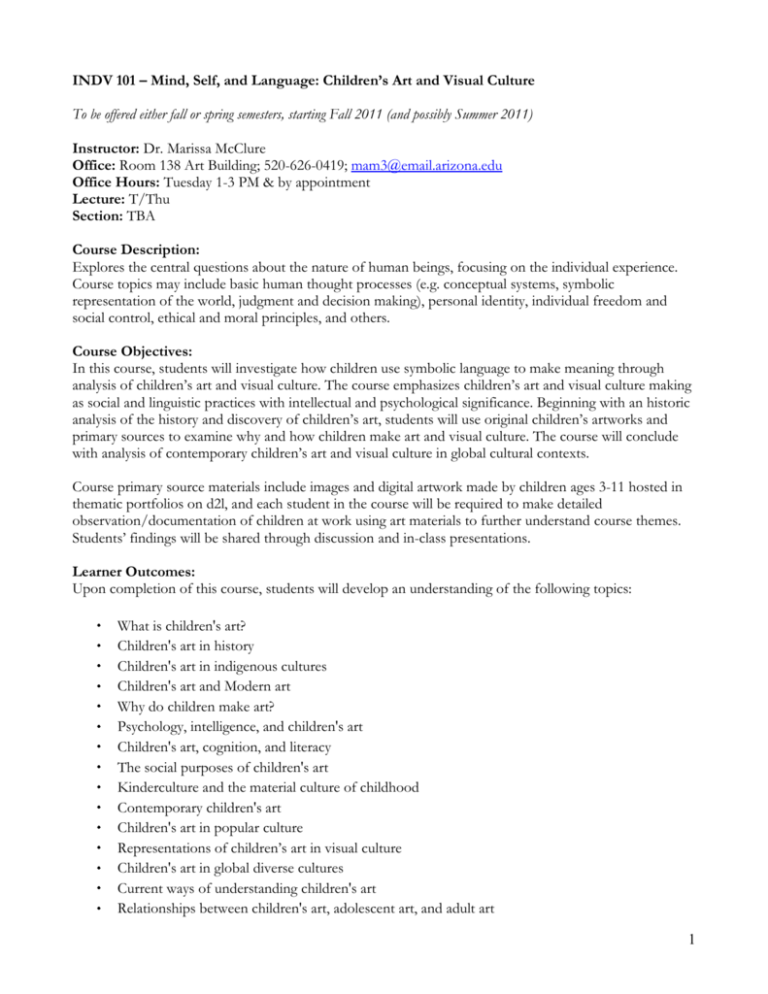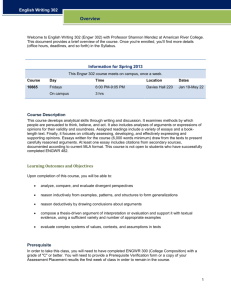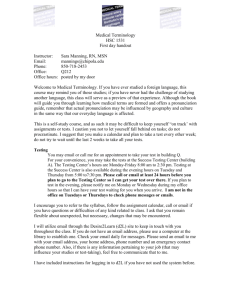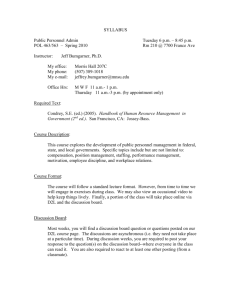COURSE # SECT Course Name
advertisement

INDV 101 – Mind, Self, and Language: Children’s Art and Visual Culture To be offered either fall or spring semesters, starting Fall 2011 (and possibly Summer 2011) Instructor: Dr. Marissa McClure Office: Room 138 Art Building; 520-626-0419; mam3@email.arizona.edu Office Hours: Tuesday 1-3 PM & by appointment Lecture: T/Thu Section: TBA Course Description: Explores the central questions about the nature of human beings, focusing on the individual experience. Course topics may include basic human thought processes (e.g. conceptual systems, symbolic representation of the world, judgment and decision making), personal identity, individual freedom and social control, ethical and moral principles, and others. Course Objectives: In this course, students will investigate how children use symbolic language to make meaning through analysis of children’s art and visual culture. The course emphasizes children’s art and visual culture making as social and linguistic practices with intellectual and psychological significance. Beginning with an historic analysis of the history and discovery of children’s art, students will use original children’s artworks and primary sources to examine why and how children make art and visual culture. The course will conclude with analysis of contemporary children’s art and visual culture in global cultural contexts. Course primary source materials include images and digital artwork made by children ages 3-11 hosted in thematic portfolios on d2l, and each student in the course will be required to make detailed observation/documentation of children at work using art materials to further understand course themes. Students’ findings will be shared through discussion and in-class presentations. Learner Outcomes: Upon completion of this course, students will develop an understanding of the following topics: What is children's art? Children's art in history Children's art in indigenous cultures Children's art and Modern art Why do children make art? Psychology, intelligence, and children's art Children's art, cognition, and literacy The social purposes of children's art Kinderculture and the material culture of childhood Contemporary children's art Children's art in popular culture Representations of children’s art in visual culture Children's art in global diverse cultures Current ways of understanding children's art Relationships between children's art, adolescent art, and adult art 1 Course Materials and Supplies: Required Texts & Required Reading: Hurwitz, A. & Carroll, K. (2008). Memory & experience: thematic drawings by Qatari, Taiwanese, Malaysian, and American children. Reston, VA: National Art Education Association. Additional required readings and course media will be hosted on the course d2l site in PDF format (you may download a free version of Adobe Acrobat here: http://www.adobe.com/products/acrobat/readstep2.html) Please see course calendar, which is attached Supplies: Internet access; Required readings; A scanner and/or digital camera, if necessary, to complete projects. Course Requirements & Project Descriptions: Students will be expected to be prepared for each in-class discussion. Participation in all aspects of the course accounts for 25 points (12.5% of your final course grade). Students will be expected to submit a one-page written response upon course readings once weekly, for a total of ten responses during the duration of the course. Each response must conclude with a question that students post to the appropriate online discussion. The purpose of the response is for students to synthesize issues presented in the readings. The response is not a summary but rather a response to an issue presented in the course readings/media. Preparation for these responses includes thoughtfully reading and reflecting upon the course readings and their relevance to the images hosted on our d2l site. All responses must be uploaded to the appropriate d2l dropbox (along with supplementary media). The dropbox will be closed at this time. Responses should include students’ name in the title and should be saved in .doc format (example: LastNameResponseWeek1). Responses not submitted in this format will not be assessed, and will be subject to the late work policy. Responses submitted after the deadlines are subject to the latework policy. These responses account for 100 points of students’ course grade (50%), or 10 points per response—eight points for the thoughtfulness of the response in regards to issues presented in the reading, for conventions and style, and two points for the question you pose. Responses to readings and course media should be a minimum of one typed page, using a standard 12 pt. font and should stand on their own as concise, complete, and thoughtful pieces of academic writing. Three times throughout the semester, students will have a choice of two projects related to course images and materials. Students will turn in a total of three projects, and present to the class your findings in one of them during the final week of class sections. Late work will be subject to the late-work policy. Brief project descriptions will be uploaded to “Content” on our d2l site. These projects account for 75 points of students’ course grade, and participation in project presentations and accompanying discussions accounts for 25 points, for a total of 100 (50%). Projects must be a minimum of three typed pages, using a standard 12 pt. font and should stand on their own as concise, complete, and thoughtful pieces of academic writing. Images/media that accompany projects must be included in the body of the project. Honors Contract: Please contact the instructor the first day of class to create an Honors experience 2 through a contract negotiated between us. Attendance Policy: Please notify the instructor in advance if you must miss a class by sending an email message. Work you miss due to absence can be made up only under very exceptional circumstances. If you are absent, it is your responsibility to find out what you missed during the class session. Over two absences (excused or unexcused) will result in a lowering of your final grade one third grade per additional absence. If you are more than fifteen minutes late to class, you will be considered absent. If you are more than five minutes late twice, you will be marked as having an absence. Although I reserve the right to administratively drop you from the class after the third absence or if you do not attend our first class meeting, dropping the course (if you choose to do so) is your responsibility and you should attend to it promptly. All holidays or special events observed by organized religions will be honored as excused for those students who show affiliation with that particular religion. Absences pre-approved by the UA Dean of Students (or Dean’s designee) will be honored as excused. Please note: Any unexplained absences in this course will result in automatic reduction of your final grade by at least one half of a letter grade. GRADING: Grade Policies & Distributions: Grades and attendance for this class are recorded in the university’s online gradebook, Webroster. Students will be assessed upon the intensity of their engagement in the experiences, attention to detail, willingness to exceed minimum expectations, and contributions to the class as a whole. Reading reflections will be assessed as to how they reflect consistent reading and interpretation of course materials. Reflections and questions for our online discussions should be thoroughly and thoughtfully prepared and directly related to course material. Any student who fulfills these criteria thoroughly and thoughtfully is capable of earning a B in this course. Those who consistently display exceptional effort and involvement will earn an A. Grading standards at the University of Arizona are higher for graduate students. Grades cannot be discussed with students via email; you are welcome to call me with questions. Grade Policies: A: (90-100%) The student fulfills all course requirements and performs at a superior level. B: (80-89%) The student fulfills all course requirements and performs at an above-average level. C: (79-70%) The student fulfills all course requirements and performs at an average level. D. (69-60%) The student fulfills all course requirements but performs at a below-average level. E. (59% and below): The student fails to fulfill all course requirements and performs at a poor level. The grade of Incomplete will be assigned ONLY under the following circumstance: only a small percentage of the semester’s work is still outstanding and was not completed due to a documented medical emergency. Grade Distribution: Grade category Weekly responses Projects + presentation/participation Point values 100 points (10 points per response) 100 points (25 points per project; 25 points 3 Total presentation + participation) 200 points Additional Class Policies: Preparation and deadlines: It is essential to be prepared and to meet course deadlines. Expectations and deadlines are outlined in the daily calendar posted under “Content” in d2l. Please check the d2l news feed and your d2l email once daily, as the calendar is subject to change and is our primary means of communication. Expectations will be shared at the beginning of each class period for the following course meeting. For unexcused absences, in class work cannot be made up and other assignments that are late may not be accepted. Written work: Written work must be typed, proofread, double-spaced, and submitted on time. Late work policy: For each calendar day (i.e. each 24 hour period after the deadline) work and your attendance grade will be reduced by ½ letter grade (for the project) and 10% (for your attendance grade, which is 10% of your final grade). Work more than one week late will not be accepted. Electronic communication/contacts: You are responsible for keeping up with the online course calendar available on the d2l site. Please check the News Feed one lecture meeting days. I will make every effort possible to post news by 8:00 AM. I will communicate with students personally via d2l email. Please contact me via d2l email only. Classroom behavior: o Cell phones and pagers: As a courtesy to all people in class, please turn off cell phones and pagers during class time. o Please maintain professional and courteous online behavior, as you would in an in-class discussion. I reserve the right to remove posts that I deem inappropriate and to deduct points from the poster’s grade accordingly (using the late-work policy guidelines). o From the University Policy on Threatening Behavior: “The aim of education is the intellectual, personal, social, and ethical development of the individual. The educational process is ideally conducted in an environment that encourages reasoned discourse, intellectual honesty, openness to constructive change and respect for the rights of all individuals. Self discipline and a respect for the rights of others in the university community are necessary for the fulfillment of such goals.” o From the University Code of Academic Integrity: “Integrity is expected of every student in all academic work. The guiding principle of academic integrity is that a student’s submitted work must the student’s own. This principle is further by the student Code of Conduct and disciplinary procedures established by ABOR Policies 5-308 – 5-403, all provisions of which apply to all University of Arizona students.” The Code of Conduct is available at http://dos.web.arizona.edu/uapolicies/scc5308f.html The Policy on Threatening Behavior is available at http://web.arizona.edu/~policy/threatening.pdf The Code of Academic Integrity is available at http://dos.web.arizona.edu/uapolicies/cai1.html ADA Statement: If you anticipate issues related to the format or requirements of this course, please meet with me. I would like us to discuss ways to ensure your full participation in the course. If you determine 4 that formal, disability-related accommodations are necessary, it is very important that you be registered with Disability Resources (621-3268; drc.arizona.edu) and that you notify me of your eligibility for reasonable accommodations. We can then plan how best to coordinate your accommodations. http://drc.arizona.edu/teach/syllabus-statement.html Disclaimers: Information contained in this syllabus and in the course calendar, other than absence and grade policies, may be subject to change with reasonable advanced notice, as deemed appropriate by the instructor. A Note on Content: The subject matter of this course contains material that may challenge or offend your moral, religious or political values and beliefs. During the course of the semester, we will encounter and discuss works of art that contain or deal with nudity, profanity, sexuality and violence. If this is an insurmountable issue for you, perhaps this course is not appropriate. A Note on Copyright: Images of children’s artwork hosted on d2l are property of my collection of children’s art. They have been collected for research and teaching purposes with the consent of children’s families, and are not intended for reproduction or distribution. Images have been treated with a watermark and are subject to copyright infringement violation if they are removed from d2l site. I appreciate your compliance. You may not use these images for work outside of this course. INDV 101 – Mind, Self, and Language: Children’s Art and Visual Culture Course Schedule Week 1: What is children's art? Lecture 1 (L1): What is children’s art? Lecture 2 (L2): The study of children’s? Section (S): Drawing activity. Week 2: Children's art in history L1: Children’s art in ancient history. L2: The rediscovery of children’s art. S: Graffiti and children’s art. Week 3: Children's art in indigenous cultures L1: Evidence of children’s art. L2: Meanings of children’s art. S: Pottery making activity. Week 4: Children's art and Modern art L1: Children’s art in 20th Century Europe. L2: Klee, Picasso, Dubuffet, and other artists on children’s art. S: Collections of children’s art from the Art Brut Museum. Week 5: Why do children make art? L1: Little Julian’s Impure drawings. L2: Bigfoot, Medium Foot, Tiny Foot. S: Art and narrative. Week 6: Psychology, intelligence, and children's art L1: Art and IQ tests. 5 L2: Art and psychology. S: Draw-A-Man test. Week 7: Children's art, cognition, and literacy L1: Art and children’s development. L2: Art and children’s thinking. S: Classifying children’s drawings. Week 8: The social purposes of children's art L1: Art in contexts. L2: Art and symbolic language, narrative, and meaning. S: Art and play. Week 9: Kinderculture and the material culture of childhood L1: Drawings by children; drawings for children. L2: The “Ket” aesthetic. S: Nostalgia and kinderculture. Week 10: Contemporary children's art L1: Children and photography. L2: Children and new media. S: Wendy Ewald, Secret Games @ Center for Creative Photography. Week 11: Children's art in popular culture L1: Project 1. L2: Project 2. S: Presentations. Week 12: Representations of children’s art in visual culture L1: My Kid Could Paint That. L2: Criminal Minds. S: Media analysis. Week 13: Children's art in diverse cultures L1: Children’s art in the Americas and Africa. L2: Children’s art in Asia, Europe, and the Middle East. S: Project 3. Week 14: Current ways of understanding children's art L1: Children’s art and symbolic language. L2: Children’s art and linguistics and meaning. S: New children’s art. Week 15: Relationships between children's art, adolescent art, and adult art L1: Art and visual culture. L2: Ways we make now. S: Project 3 Presentations. 6




